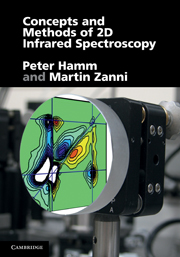Book contents
- Frontmatter
- Contents
- 1 Introduction
- 2 Designing multiple pulse experiments
- 3 Mukamelian or perturbative expansion of the density matrix
- 4 Basics of 2D IR spectroscopy
- 5 Polarization control
- 6 Molecular couplings
- 7 2D IR lineshapes
- 8 Dynamic cross-peaks
- 9 Experimental designs, data collection and processing
- 10 Simple simulation strategies
- 11 Pulse sequence design: Some examples
- Appendix A Fourier transformation
- Appendix B The ladder operator formalism
- Appendix C Units and physical constants
- Appendix D Legendre polynomials and spherical harmonics
- Appendix E Recommended reading
- References
- Index
2 - Designing multiple pulse experiments
Published online by Cambridge University Press: 05 August 2012
- Frontmatter
- Contents
- 1 Introduction
- 2 Designing multiple pulse experiments
- 3 Mukamelian or perturbative expansion of the density matrix
- 4 Basics of 2D IR spectroscopy
- 5 Polarization control
- 6 Molecular couplings
- 7 2D IR lineshapes
- 8 Dynamic cross-peaks
- 9 Experimental designs, data collection and processing
- 10 Simple simulation strategies
- 11 Pulse sequence design: Some examples
- Appendix A Fourier transformation
- Appendix B The ladder operator formalism
- Appendix C Units and physical constants
- Appendix D Legendre polynomials and spherical harmonics
- Appendix E Recommended reading
- References
- Index
Summary
Researchers that are new to the field of 2D IR spectroscopy will find an enormous literature on the mathematical formalism behind the technique. To fully understand the capabilities of 2D IR spectroscopy, one needs to know nonlinear optics, lineshape theory, quantum mechanics and density matrices, to name a few topics (see Appendix E for recommended reading material). It can take years to learn all of these topics, but for many applications such a detailed understanding is not necessary. On a day-to-day basis, researchers in the field do not dwell on these topics, but instead rely on a few methods to design and interpret experiments. In later chapters, we focus on many aspects of the detailed mathematical formalism. In this chapter, we outline a view of 2D IR spectroscopy that we think provides intuition for the interpretation and design of 2D IR experiments based on physical phenomena. We will end up with double sided Feynman diagrams that are a useful tool for designing multiple pulse experiments.
Eigenstates, coherences and the emitted field
We begin in the same way that one would do an experiment; we shine light on a molecule. Consider a molecule like the one shown in Fig. 2.1(a). It has many vibrational modes and can be oriented in any direction in the laboratory frame. Describing the vibrational modes of this molecule is the subject of Chapter 6 and calculating the signal strength for an isotropically distributed sample is the subject of Chapter 5.
- Type
- Chapter
- Information
- Concepts and Methods of 2D Infrared Spectroscopy , pp. 18 - 47Publisher: Cambridge University PressPrint publication year: 2011



